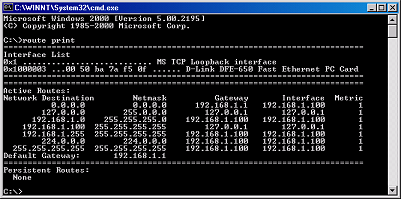
Custom Search
|
Problem:
What
is a routing table and how do I view it in Windows 2000?
Versions:
Windows 2000
The routing table is a database of IP addresses. Using the table, Windows 2000 determines which network device to send a network packet to. If you have a small network at home or work in an office, Windows will determine whether your network request should be addressed to another computer on your local network or sent to a router (or gateway) that will route your request on to an external network. For example, if you need to view a document your co-worker has been working on, Windows 2000 will directly ask your co-worker's computer for the file. Now let's say you want to visit a search engine on the Internet. Your request is sent to your Internet gateway which forwards your request on to the Internet. Every device that communicates with the TCP/IP protocol uses a routing table.
To view the Windows 2000 routing table, go to the Start button--Programs--Accessories--Command Prompt. Type route print to see your current routing table. (Entries are added and deleted as you access various resources on your network and are cleared when you restart the operating system.) Here is an example Windows 2000 routing table:
One common entry in your routing table is the local loopback
address (127.0.0.1). When a request is addressed to 127.0.0.1,
Windows 2000 checks the routing table and sees that it
should not send it to your network card, but, instead,
to one of the services running on your own computer. Another
common entry is 0.0.0.0. If the destination address is
not specified in the routing table, this entry specifies
that the network request will be sent to the default gateway.
The network destination can contain the address of a host, subnet, network, or the default gateway. The netmask determines how much of a packet's destination address must match the network address in the routing table before the route is used to deliver the packet. In other words, is the destination on the same network segment as the source? Assuming the destination address falls inside the netmask, the gateway identifies where the packet must then be sent. This can be either your computer's IP address or the default gateway address. The interface determines which device on your computer the request is sent to. The is helpful if you have two or more network cards installed and intercepts requests sent to your loopback address. Finally, the metric identifies the number of hops between your computer and the destination network address. The local network is always one hop; each router thereafter adds another hop. Your computer uses the hop count to determine the fastest route for a packet.
Last updated September 16, 2003


